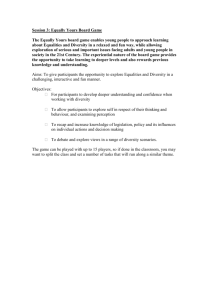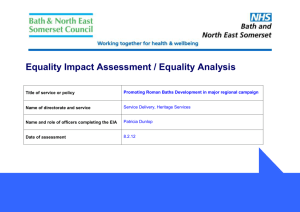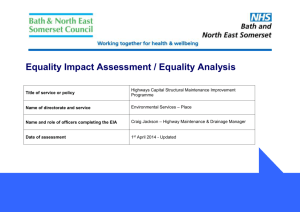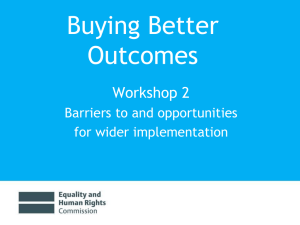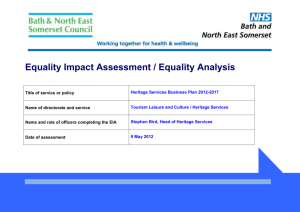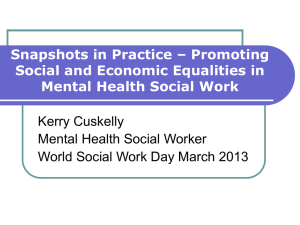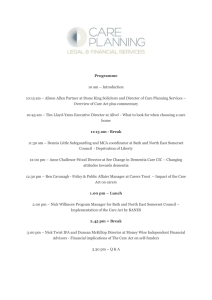Bereavement Services - Community Group Policy
advertisement
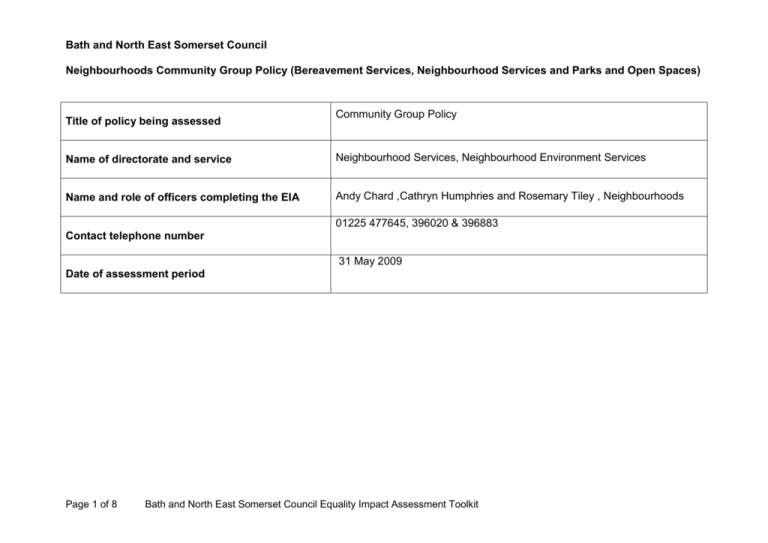
Bath and North East Somerset Council Neighbourhoods Community Group Policy (Bereavement Services, Neighbourhood Services and Parks and Open Spaces) Title of policy being assessed Community Group Policy Name of directorate and service Neighbourhood Services, Neighbourhood Environment Services Name and role of officers completing the EIA Andy Chard ,Cathryn Humphries and Rosemary Tiley , Neighbourhoods 01225 477645, 396020 & 396883 Contact telephone number 31 May 2009 Date of assessment period Page 1 of 8 Bath and North East Somerset Council Equality Impact Assessment Toolkit 1. Identify the aims of the policy and how it is implemented. Key questions Answers / Notes 1.1 Is this a new a new policy or a review of an existing one? An existing policy 1.2 What is its aim? 1.3 Whose needs is it designed to meet? To ensure services engage fully with community groups such as residents’ associations, friends’ groups, etc., to involve them in the management and maintenance of their local environment. All residents of B&NES. 1.4 Who defines or defined the policy? (e.g is it a national requirement?). How much room for review is there? Individual managers interpreting Council policy and using national best practice where it exists. 1.5 Who implements the policy? All Neighbourhood Services staff. 1.6 Are there any areas of the policy where those carrying it out can exercise discretion? If so is there clear guidance on this? 1.7 What could stop the policy from meeting its aims? (see 1.2) Yes, managers to lay down guidelines for staff to follow but there will be occasions where professional discretion will need to be employed. There is a community liaison team Monitor this work. whose objective is to engage with harder to reach sections of the community. Misinterpretation of function by Training for all relevant staff. Page 2 of 8 Bath and North East Somerset Council Equality Impact Assessment Toolkit Actions required To devise a way to monitor Equalities information. Aim to review annually. Agree a service standard agreement between groups and the council. Equalities training for all staff. Communicate understanding of issues to all staff involved (including training and monitoring). Keep records including equalities information. officers. Predisposition of certain sections of the community to communicate issues and conversely poor engagement by other sectors e.g. most groups engaging with the above services tend to consist of vocal, white, literate and middle class people (in many cases retired), whilst less vocal, shyer, less able, less socially acceptable, ethnic minorities, or simply those with less time to spare (e.g. younger people with families) tend not to participate. 1.8 Do the aims of this policy link to or conflict with any other policies of the Council? They link to council’s vision and core values to make people ‘feel safer’ in their communities and ‘improving the public realm’. 1.9 Is responsibility for the implementation of this policy shared with other bodies? Yes e.g. Somer Housing, police, other directorates of council, Parochial Church Councils. Investigate their Equalities policies, monitoring and ask for copies. 2. Consideration of available data, research and information Answers / Notes Actions required These are existing staff who are familiar with council’s standards through Team Briefings and are managed appropriately by fully Include in personality requirements for relevant posts, with questions at interview stage. Equalities training for all staff. Key questions 2.1 What do you already know about people who use and deliver the policy? Page 3 of 8 Bath and North East Somerset Council Equality Impact Assessment Toolkit trained managers. None. 2.2 What quantitative data do you already have? (e.g census data, staff data, customer profile data etc) 2.3 What qualitative data do you already have? (e.g results of customer satisfaction surveys, results of previous consultations, staff survey findings etc). What additional information is needed to check that all equality groups’ needs are met? (see section 4). Do you need to collect more data, carry out consultation at this stage? None. How are you going to go about getting the extra information that is required? Contact stakeholders and groups as above 2.4 2.5 Consultation with ‘in-house’ equalities groups to suggest ways of monitoring. To devise a way to monitor Equalities information. Look at existing data such as census information. To devise a way to monitor Equalities information. Agree a timetable between managers to contact such groups and set up meetings as soon as can be arranged, with a target to complete by 31st March 2010. Each manager to list and contact stakeholders and groups with a target to complete by 31st March 2010. 3. Formal consultation (include within this section any consultation you are planning along with the results of any consultation you undertake) 3.1 Key questions Who do you need to consult with? 3.2 What method of consultation can be used? 3.3 What consultation was actually carried out as part of this EIA and with which groups? 3.4 What were the main issues arising from the consultation? Page 4 of 8 Answers/notes Groups as stated in 2.4 & 2.5 above. Groups as stated in 2.4 & 2.5 above. N/A N/A Bath and North East Somerset Council Equality Impact Assessment Toolkit Actions required 4. Assessment of impact Based upon any data you have analysed, or the results of consultation or research, use the spaces below to list how the policy will or does actually work in practice for each equalities strand: 1. Consider whether the policy meets any particular needs of each of the six equalities groups. 2. Identify any differential impact (positive or adverse) for each of the six equalities groups 3. Include any examples of how the policy or service helps to promote race, disability and gender equality. Impact or potential impact (negative, positive or neutral) 4.1 Gender – identify the impact/potential impact of Neutral. the policy on women, men and transgender people 4.2 Disability - identify the impact/potential impact of the policy on disabled people (ensure consideration of a range of impairments including visual and hearing impairments, mobility impairments, learning disability etc) Neutral/positive - Some participants will be vulnerable and extra skill will be required to communicate effectively with this group. 4.3 Age – identify the impact/potential impact of the policy on different age groups Neutral/positive - Some participants will be vulnerable and extra skill will be required to communicate effectively with this group. 4.4 Race – identify the impact/potential impact on different black and minority ethnic groups Neutral/positive - Some participants will be vulnerable and extra skill will be required to communicate effectively with this group.. Page 5 of 8 Bath and North East Somerset Council Equality Impact Assessment Toolkit 4.5 Sexual orientation - identify the impact/potential impact of the policy on lesbians, gay men, bisexual and heterosexual people Neutral 4.6 Religion/belief – identify the impact/potential impact of the policy on people of different religious/faith groups and also upon those with no religion. Neutral Key questions Answers/notes Have you identified any areas in which the policy is discriminatory? If you answer yes to this please refer to legal services on whether this is justifiable within legislation. If you have identified any adverse impact(s) can it be avoided, can we make changes, can we lessen it etc? (NB: If you have identified a differential or adverse impact that amounts to unlawful discrimination, then you are duty bound to act to ensure that the Council acts lawfully by changing the policy or proposal in question). Is there any additional action you can take to meet the needs of the six equalities groups above? No 4.7 4.8 4.9 5. Actions required Yes – this policy addresses the issues to lessen the impact No – policy designed to meet these needs. Internal processes for the organisation – to be explored at the end of the EIA process. Page 6 of 8 Bath and North East Somerset Council Equality Impact Assessment Toolkit Making a decision in the light of data, alternatives and consultations Key questions Answers/notes Actions required How will the organisation’s decision making process be used to take this forward? Mangers will take responsibility for equalities monitoring. All staff to be aware and take ownership of equalities concerns. Key questions Answers/notes Actions required 5.3 What have we found out in completing this EIA? What can we learn for the future? Who will carry out monitoring? Lack of information about the profile of these groups. Relevant managers To devise ways to monitor Equalities information. To be added to work plan 5.4 What needs to be monitored? Consistency of approach. To be added to work plan 5.5 What method(s) of monitoring will be used? To be determined 5.6 Will the monitoring information be published? Yes – as appropriate on public website. 5.1 Monitoring for adverse impact in the future 5.2 Publication of results of the equality impact assessment Answers/notes Actions required Key questions 5.7 Who will write up the EIA report? 5.8 How will the results of the EIA be published? Page 7 of 8 Cathryn Humphries, Andy Chard & Rosemary Tiley On B&NES website Bath and North East Somerset Council Equality Impact Assessment Toolkit Sign off by DLEG monitors and passed to Equalities Team to be published. 6. Bath and North East Somerset Council Equality Impact Assessment Improvement Plan Title of service/function or policy being assessed: Neighbourhoods Community Group Policy (adopted by Bereavement Services, Neighbourhood Services and Parks and Green Spaces) Name and role of officers completing assessment: Cathryn Humphries, Andy Chard and Rosemary Tiley Date assessment completed: 31st May 2009 Issues identified Actions required Progress milestones Lack of existing equalities information. Monitoring of profile of community groups that we work with and compare with census data. Managers agree evaluation form. Consult. Implement. Staff need to be trained and take ownership of policy Training courses. Staff involvement. Training achieved. Team briefings to include equalities issues. Consultation needed Involve council’s staff groups Consult. Implement suggestions. Lack of knowledge of partner organisiations’ equalities policies. Consult. Record. Page 8 of 8 Bath and North East Somerset Council Equality Impact Assessment Toolkit Officer responsible Cathryn Humphries, Andy Chard & Rosemary Tiley and relevant managers Cathryn Humphries, Andy Chard & Rosemary Tiley Cathryn Humphries, Andy Chard & Rosemary Tiley Cathryn Humphries, Andy Chard & Rosemary Tiley By when Dec 2009 Dec 2009 Dec 2009 Dec 2009
